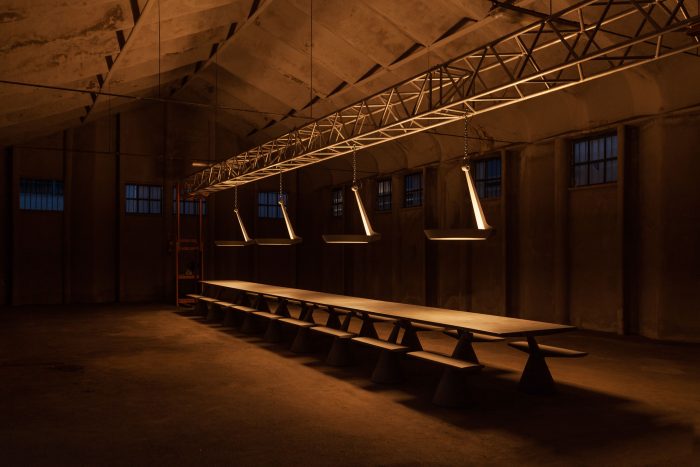Magliana项目是由柏林设计师Konstantin Grcic为Giustini / Stagetti设计的极简主义系列。主要受到建筑和工程作品Pier Luigi Nervi的建筑原则的启发,Konstantin Grcic的项目展示了限量版家具,包括带有集成座椅和悬挂照明的模块化桌子,所有这些都完全由混凝土完成。从材料的最新研究及其小规模应用开发的创新技术。考虑到康斯坦丁•格里奇对Pier Luigi Nervi工作的兴趣以及两位大师的愿景中的重叠领域,决定将Grcic的项目展示在一座建筑中,该建筑象征着伟大的意大利建筑工程师的著名遗迹:唯一幸存的亭子(Padiglione)来自“Nervi&Bartoli”公司拥有的大型现成建筑校园,
这个小型的工程杰作,今天作为停车场,是钢筋混凝土首次实验性使用的重要历史记录:是Nervi最具革命性的发明之一。由于钢筋网和混凝土成分的强度和弹性,钢筋混凝土的创新使得Nervi能够克服由于水泥的整体重量和承载能力而导致的结构问题。它同时保证了他的设计的垂直“活力”和以前在建筑中无法想象的建筑美学。今天,纤维增强混凝土的生产使水泥能够应用于一系列新用途,因为它增加了强度并显着减轻了重量; 此外,材料的表面可以更均匀地完成,因此材料可以用于更广泛的应用。就Grcic的实践而言,在实践层面上,纤维增强混凝土已经允许其应用于日常家用的功能性物品的创造,而在正式水平上,其质量允许精确再现设计,包括其特征。标志性图案:几何形状,体积和透视。
“Magliana项目”专门介绍了Grcic正在进行的两个不同设计领域的重要研究:照明和座位 – 他的项目总是通过他的项目有助于定义新的视野或分水岭时刻。人道主义对象的方法,它的功能,以及它的概念和美学品质。在这方面,塔架/座椅和悬挂灯已经过长期,深入的工程研究,这些研究已经实现了形式和功能的高度标志性的完美平衡。在分享Nervi表达工程美学的某些独特特征时,例如形式连贯性,结构活力,不朽的原型以及最重要的是“对材料的诚实”
Magliana Project is a minimalist collection created by Berlin-based designer Konstantin Grcic for Giustini / Stagetti. Inspired by the building principles of Pier Luigi Nervi, the author of major architectural and engineering works, Konstantin Grcic’s project presents a corpus of limited edition furniture, consisting of modular tables with integrated seating and suspension lighting, all executed entirely in concrete according to the most innovative techniques developed from the latest studies on the material, and its small scale application. Given Konstantin Grcic’s interest in the work of Pier Luigi Nervi and the areas of over-lap in the two master’s vision, it was decided to present Grcic’s project in a building that is emblematic of the great Italian architectural-engineer’s celebrated history: the only surviving pavilion (Padiglione) from the larger campus of ready-made buildings occupied by the firm “Nervi & Bartoli”, the company founded by Nervi in 1932, which from the 1940s was headquartered in the Magliana area of Rome.
This small masterpiece of engineering, which today serves as parking lot, is an important historical record of the first experimental use of ferro-concrete: among the most revolutionary inventions by Nervi. The innovation allowed by ferro-concrete, given its strength and elasticity resulting from its steel-mesh and concrete composition, allowed Nervi to overcome structural issues resulting from the overall weigh and load-bearing capacity of cement. It simultaneously guaranteed the vertical “dynamism” of his designs and a construction aesthetic that would previously have been unthinkable in architecture. Today, the creation of fibre re-enforced concrete has allowed cement to be applied to a series of new uses owing to its increased strength and significantly reduced weight; additionally the material’s surface can be more uniformly finished and consequently the material can be deployed for a greater range of applications. In the case of Grcic’s practice, on the practical level, fibre re-enforced concrete has allowed its application to the creation of functional objects for daily domestic use, while on a formal level, its qualities permit the precise reproduction of the design including his characteristic signature motifs: geometries, volumes and perspectives.
“Magliana Project” specifically presents an important compound of Grcic’s on-going research in two distinctive areas of design: lighting and seating – terrains in which his projects have always contributed to the definition of a new vision or watershed moments in the field, through his humanist approach to the object, its functionality, and its conceptual and aesthetic qualities. In this regard the pylon/seat and the suspension lamp have been subject to long, in-depth engineering studies that have resulted in the attainment of a highly iconic, perfect balance of form and function. In sharing certain distinctive traits of Nervi’s expressive engineering aesthetic, such as formal coherence, structural dynamism, the monumental archetype and above all his ‘honesty to materials’, Konstantin Grcic pays homage to the great Italian genius with his latest work, which is destined to become a new classic of his repertoire, and of collectable design at large.
Design: Konstantin Grcic
Photography:Omar Golli











